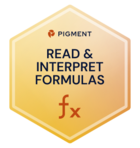Could anyone provide some guidance on when to use the function SEASONAL_LINEAR_REGRESSION over FORECAST_ETS? In our specific case we have a metric with a yearly seasonality and the overall trend for the metric is going slightly downwards. We would like to use our actuals data to automatically calculate values for all forecast months. I can see that both functions gives me reasonable values for my forecast, but FORECAST_ETS gives me a clearer trend downwards while SEASONAL_LINEAR_REGRESSION gives me more flat forecast.
So my question is really, which one would make most sense to use in our case and why?
FORECAST_ETS vs SEASONAL_LINEAR_REGRESSION
Best answer by Thu Mai
Hi Ola, overall, your question is also more about the definition and nature of statistical forecast methods, rather than just the Pigment formulas themselves.
1. Why this method gives me a clearer trend downwards while the other method gives me more flat forecast?
- SEASONAL_LINEAR_REGRESSION - multiplicative decomposition of a time series, it computes a linear regression and taking seasonality into account. To use this method, you have to input Seasonality length.
- FORECAST_ETS is Triple Exponential Smoothing - a statistical algorithm for time series forecasting based on the Holt-Winters model. ETS model three aspects of the time series: average, trend, and seasonality. To use this method, you have to input Seasonality length, alpha - data smoothing factor, beta - trend smoothing factor, gamma - seasonal change smoothing factor.
→ As you can see, depends on your input for alpha, beta, gamma and seasonality length, the result/forecast outcome will change dramatically, this maybe explains why in certain cases, your forecast seems flatter or not as expected.
2. Which one would make most sense to use in our case and why?
- There is no specific answer here, we have many statistical forecast methods, not just the 2 methods above, to choose which forecast will be the best fit forecast we can not choose it based on our feeling or sensing, everything forecast has to be based on science/statistical/mathematical calculation base, in this case, long story short, you have to calculate your forecast accuracy by certain drivers (WMAPE, MAPE, Bias...) and then build other metrics to choose the best fit method base on the minimum value.
Hope my answer helps 😊
Enter your E-mail address. We'll send you an e-mail with instructions to reset your password.






